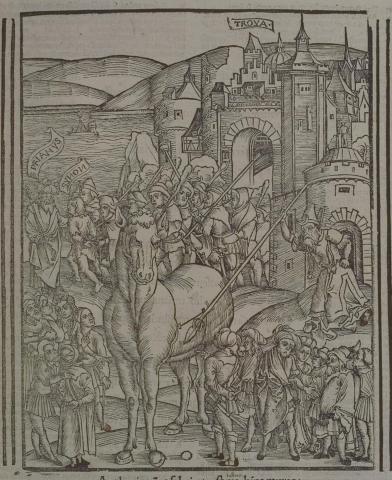Annotations
In this scene, the Trojans are uncertain what to do with the wooden horse. Below the horse, on either side, a crowd of Trojans ponders what to do with the horse (38). Laocoon, to the right of the horse, hurls his javelin at the horse, in an attempt to discover whether anything might be inside (40-53). Laocoon wears a cap with a crescent, to represent his role as priest of Neptune (201-2). Behind the horse, the Trojans lead a Greek captive, Sinon, to King Priam. Sinon, named in line 79, was left by the Greeks to be captured so he could plant a story with the Trojans (57-76; his tale is 77-144). (Katy Purington)
Woodcut illustration from the “Strasbourg Vergil,” edited by Sebastian Brant: Publii Virgilii Maronis Opera cum quinque vulgatis commentariis expolitissimisque figuris atque imaginibus nuper per Sebastianum Brant superadditis (Strasbourg: Johannis Grieninger, 1502), fol. 159r, executed by an anonymous engraver under the direction of Brant.


Sebastian Brant (1458–1521) was a humanist scholar of many competencies. Trained in classics and law at the University of Basel, Brant later lectured in jurisprudence there and practiced law in his native city of Strasbourg. While his satirical poem Das Narrenschiff won him considerable standing as a writer, his role in the transmission of Virgil to the Renaissance was at least as important. In 1502 he and Strasbourg printer Johannes Grüninger produced a major edition of Virgil’s works, along with Donatus’ Life and the commentaries of Servius, Landino, and Calderini, with more than two hundred woodcut illustrations. (Annabel Patterson)